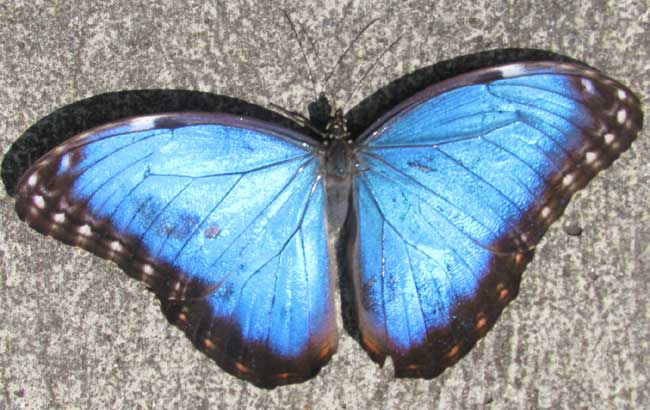Excerpts from Jim Conrad's
Naturalist Newsletter

from the November 7, 2010 Newsletter issued from Hacienda Chichen Resort beside Chichén Itzá Ruins, central Yucatán, MÉXICO; limestone bedrock, elevation ~39m (~128ft), ~N20.676°, ~W88.569°
A BLUE MORPHO CRASHES
Morphos may be the best known of all tropical butterflies because of their big size (about 4.5 inches, or 11 cm, across), their commonness and their beauty. With their metallic-blue upper wing surfaces they're unforgettable as they brightly flutter through sunlight, the dark forest providing a somber backdrop.
Last June we met our local Common Blue Morpho, MORPHO HELENOR MONTEZUMA, but then I could only show you the species' drably brown wing-undersides, for as soon as a morpho landed on my compost heap he'd fold his wings over his back, camouflaging himself against the brown litter. You can see one doing exactly that in the next picture, below.
I figured I'd never get a shot of one's dazzlingly blue upper wing surfaces, for the blue only shows during flight, and when the butterflies are at rest and unexpectedly and briefly spread their wings. Then their surprising display possibly shocks potential predators into moving, revealing their presence so the butterfly knows to escape.
Morphos are common here, but unless they find a mushy banana atop the compost heap, inevitably they just flutter through and never land. Also I see them when I bike quiet little backroads around Pisté. Then, as I ride down the road it's typical for a morpho suddenly to appear right in front of me, matching his speed with mine, flying before me as if he were my guide. Then with each flap those wings absolutely detonate with blueness, one explosion after another. This happens so frequently that surely it's no coincidence. I'm thinking that for some reason morphos simply like flitting along in front of a larger traveler.
So, last Sunday as I returned from Pisté, a big morpho flitted from the shadowy woods onto the main highway near the ruin entrance. Maybe it wanted to guide a car awhile...
The poor morpho quickly got smashed right in front me and crashed onto the pavement, able to flap but no longer capable of flying.
At first I just pedaled past him, experiencing a pang of melancholy. But then it occurred to me that at least the creature's ruin could serve to bring a moment of reflection and gratitude to you who read this, so I turned back and got out the camera.
So, that's the morpho at the top of this page, dying with its exquisite wings spread not fleetingly against the forest's dark, welcoming shadows, but for a minute or two against hot, hard graininess of the highway a kilometer east of Pisté, before the ants arrive to tear it apart.

from the June 13, 2010 Newsletter issued from Hacienda Chichen Resort beside Chichén Itzá Ruins, central Yucatán, MÉXICO; limestone bedrock, elevation ~39m (~128ft), ~N20.676°, ~W88.569°
A MORPHO'S FOLDED WINGS
No other butterfly evokes the beauty, mystery and biodiversity of the American Tropics more than the Blue Morpho. Mention one, and those with a little tropical savvy visualize a very large, slowly flapping butterfly with resplendently powder-blue wings flitting in and out of beams of sunlight, the forest's dark green lushness as a backdrop, each flap of the butterfly's wings a veritable visual explosion of dazzling blueness.
I didn't know whether we'd have Morphos here -- mostly I've seen them in areas with more rainfall -- until this week, when one settled on my compost heap, then couldn't leave his deliquescing banana peeling as I inched forward with the camera. About the size of a saucer, as soon as a Morpho lands it folds its wings over its back, hiding its wings' blue upper surfaces, displaying only the much more muted undersides, seen above.
There's more than one kind of Morpho. My compost one can be identified as the Common Blue Morpho, MORPHO HELENOR, a species first described by science in 1776. Morpho helenor is distributed from Mexico through Central America to Brazil and Argentina, occupying habitats ranging from our dry, semideciduous woodlands to Amazonian rainforests and Andean cloudforests. Being present in so many habitats over such a large distribution, it's not a surprise that this species is fracturing into many populations especially adapted to their local conditions.
In fact, the name Morpho helenor often is used as a catch-all name representing a "species group" -- many very similar populations, the species status of which may be much disputed by the experts. Nowadays about 29 populations are recognized as different enough from one another to merit their own species name. So, is my compost Morpho the "real" helenor? The best we can do now is to file it under that name on the Internet and let some later expert figure it out.
Morpho caterpillars feed on trees in the Bean Family and woody vines (lianas) in the Bignonia Family -- both families very well represented here.